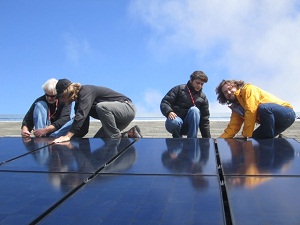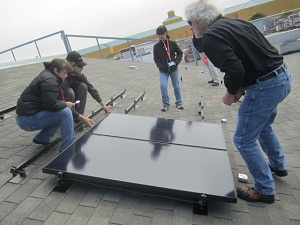SunPower demonstrates solar installation before Intersolar
 All we needed was a 7/16th socket wrench. Today, (July 11) a group of media representatives had a chance to install solar panels on a rooftop—albeit a rooftop used for training at SunPower Corp.’s (NASDAQ: SPWRA, SPWRB) Richmond, Calif., facility.
All we needed was a 7/16th socket wrench. Today, (July 11) a group of media representatives had a chance to install solar panels on a rooftop—albeit a rooftop used for training at SunPower Corp.’s (NASDAQ: SPWRA, SPWRB) Richmond, Calif., facility.
And it was easy.
At the beginning of the Intersolar conference, held in San Francisco this week, SunPower invited media to join them for a day, getting a hands-on demonstration of how a photovoltaic array is installed, talking with their executives and seeing how they produce silicon photovoltaics—more on the latter two later. But for now, let’s talk about installing solar.
“In essence, everyone’s going to be doing what’s truly the most glamorous part of solar installation, which is laying down the modules, connecting them and turning it on. But there’s a lot of hard work that goes on before that,” said Chris Sommerfeld, a senior technical trainer with SunPower.
We didn’t get the whole installation training; that takes two days and includes more work, like installing the inverter, the disconnect and other vital parts of a net-metered photovoltaic system. But we did get to do the most satisfying part, mount the modules, turn them on and watch the system run the meter backwards.
We installed what Sommerfeld called a pretty typical installation on an average house in the U.S., using eight SunPower black modules in two rows. I can’t say this is how every photovoltaic system is installed, but it’s a pretty straight-forward procedure.
“A lot of the actual installation of modules is aesthetics and illusion,” Sommerfeld said. “You want to make sure they’re straight and plumb, so when we put the first one down that’s that building block. Installers will use things like the gutter, so they’ll eye them to make sure the module is parallel to the gutter.”
“It’s a little different than, say, when you’re building a house. When you’re building a house, and you’re framing the house, everything’s got to be straight and plumb and level,” Sommerfeld said. “But really, with solar, we’re the icing on the cake. We’re the last thing, and it’s really hard to make something totally square and perfect on top of an un-square house.
“So a lot of what a solar installer does is use the art of the illusion. They’ll say I’m going to match the gutter, because it’s not totally square, but that’s what the person on the ground is going to have as a reference point. So even though maybe it’s diving down, just matching the gutter is the lesser of two evils to blend it in,” he said.
We wired the modules into series using touch-safe connectors.
“The series connections are really simple. You have two different connector types. You’ve got the male and the female, and they get together, and they click right into place,” Sommerfield said.
Between four members of the media and Sommerfeld, we were able to install the eight modules within about a half hour, tightening the clamps with a ratcheting socket wrench. In all honesty, the hardest parts of the installation were eyeballing the modules to make sure they were parallel with the gutter edge of the roof and making sure that the modules were properly grounded to the mounting beams and, of course, the whole system. That’s because the modules had to be properly situated on little pieces of metal with teeth that bite into the module frame.
While we got to do the glory job, installing the panels, we didn’t get to install the inverter, the brains or bean-counter of the operation. The inverter works to maximize the amount of electricity the photovoltaics are putting out, Sommerfield said.

“So it’s constantly tracking that maximum power-point voltage anywhere from six to 15 times a second,” he said. “So it’s working really, really hard to make sure the array is staying honest and producing as much as it can in the environmental conditions.”
Even without our extensive training experience, a real team of solar installers can install a residential solar system from start to finish in about two days, according to Sommerfeld.
During the first day they do a lot of the heavier work, installing the junction box, the wiring and conduits—which includes bending the conduit into place and attaching it to the home, the back-feed breaker, the inverter, the mounting system, and they do any necessary roof penetrations.
On the second day, they finish up any of the work left over from the first day and install the solar panels, then test the system, and show the homeowner how the system is now capable of feeding power back onto the grid.
Team media’s system spun the meter backwards, albeit slowly, thanks to the slightly overcast, cool Pacific summer air. We were delighted.



